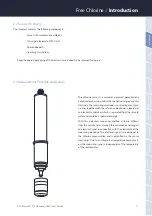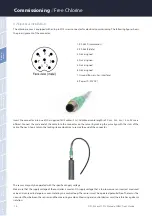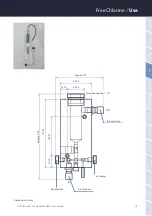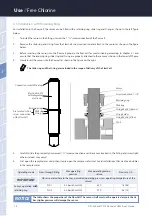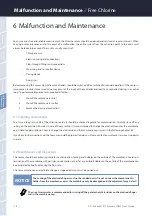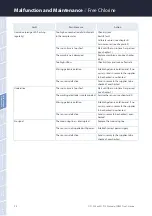
19
Us
e
Us
e
Calibr
ation
Calibr
ation
M
alfunc
tion and
M
ain
tenanc
e
M
alfunc
tion and
M
ain
tenanc
e
Comm-
issioning
Comm-
issioning
In
tr
oduc
tion
In
tr
oduc
tion
G
ener
al
Inf
or
ma
tion
G
ener
al
Inf
or
ma
tion
FA
Q
FA
Q
Technical
Da
ta
Technical
Da
ta
W
ar
ran
ty
W
ar
ran
ty
Cust
omer
ser
vic
e
Cust
omer ser
vic
e
Con
tac
t
Con
tac
t
Key
w
or
d
Inde
x
Key
w
or
d
Inde
x
Ac
cessor
ies
Ac
cessor
ies
D01-905en201912 Manual eCHEM Free Chlorine
Free Chlorine
//
Malfunction and Maintenance
6.2.1 Electrolyte Replacement
It is recommended to replace the electrolyte once a year or when an adjustment is no longer possible due to readings that are
unstable or too low.
The hose ring that closes the valve opening (located above the label) is lifted off the side of the membrane cap so that the
opening is exposed (see figure below left).
The membrane cap is unscrewed and air flows through the uncovered valve opening. The electrode finger is rinsed with clean
water and dried with a clean paper towel. Only the tip of the dry electrode finger (=measuring electrode) is cleaned with the
enclosed special sandpaper. To do this, place the special sandpaper on a paper towel, hold it at one corner and run the elect-
rode tip of the vertically held sensor two to three times over the sandpaper (see figure below right). Place the hose ring of the
membrane cap back on the valve opening and fill the membrane cap with electrolyte bubble-free (see section 3.1).
If the sensor then still indicates too low or unstable values, a new membrane cap must be used.
6.2.2 Membrane cap replacement
It is recommended to replace the membrane cap once a year or when an adjustment is no longer possible due to readings that
are unstable or too low.
The hose ring that closes the valve opening (located above the label) is lifted off the side of the membrane cap so that the
opening is exposed (see figure left).
The membrane cap is unscrewed and air flows through the uncovered valve opening. The electrode finger is rinsed with clean
water and dried with a clean paper towel. Only the tip of the dry electrode finger (=measuring electrode) is cleaned with the
enclosed special sandpaper. To do this, place the special sandpaper on a paper towel, hold it at one corner and run the electro-
de tip of the vertically held sensor two to three times over the sandpaper (see figure right). Take a new membrane cap and fill
it with electrolyte bubble-free (see section 3.1).
If the sensor then still indicates too low or unstable values, it must be checked by the manufacturer.
Shifted hose ring
Cleaning with special sandpaper
If the hose ring is not removed, the membrane could be damaged.
If the hose ring is not removed, the membrane could be damaged.
NOTICE
NOTICE
Summary of Contents for Free Chlorine
Page 1: ...Free Chlorine OPERATING INSTRUCTIONS...
Page 2: ......



